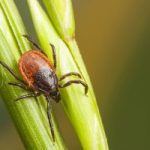The latest study on Lyme disease suggests that detection tests are proving to give false positive results. This means that some patients might be mistakenly diagnosed when the disease is actually not present. New research has studied the introduction of new tests that have modified microscopy techniques detecting active cases of Lyme disease in just one to two days. The problem with these tests is that the reliability of them has still not been validated to use in patients. In an accompanying editorial commentary, Dr Ram B. Dessau, an expert on infectious diseases and senior consultant at Slagelse Hospital in Denmark, writes, “I hope the study serves as a warning against non-validated microscopic procedures and helps prevent mismanagement of patients with chronic complaints, who are lured to seek improper diagnosis in the future.” Read further to learn more about the latest news and discoveries on Lyme disease.
 Tick-borne illnesses, Lyme disease, treated in mice with combination therapy
Tick-borne illnesses, Lyme disease, treated in mice with combination therapy
A new study has found that combination therapy is successful in treating tick-borne illnesses, like Lyme disease, in mice. The researchers found the combination therapy cured babesiosis, which is an emerging threat transmitted by the same ticks that spread Lyme disease. The treatment not only clears the infection, but also prevents recurrence, which sets combination therapy apart from other modes of treatment.
Advertisement
Babesiosis is caused by B. microti parasite, which is transmitted through tick bites. Individuals infected by babesiosis are often asymptomatic, but might display a range of symptoms from flu-like to even life threatening. The parasite can develop resistance to existing therapies and cause relapses after treatment. Continue reading…
 Lyme disease and autism association debunked in newer study, previous research suggested a link
Lyme disease and autism association debunked in newer study, previous research suggested a link
Lyme disease and autism association – suggested by previous research – has been debunked with a newer study. Even though Lyme disease has been reported to have a 20 percent prevalence among children with autism, the new study did not uncover any cases of Lyme disease in children with autism.
Experts are concerned that if parents of children with autism believe that Lyme disease is the cause they will seek out long-term antibiotic care.
Senior author Armin Alaedini said, “Unless a child has been diagnosed with Lyme disease or another infectious disease, our findings don’t support the idea of putting autistic children on antibiotics.”
Autism is a brain disorder that hinders a child’s ability to communicate or interact socially.
Lyme disease is brought on by bacteria transmitted through a tick bite.
To conduct their study, the researchers analyzed blood samples of 70 autistic children and 50 children without the disorder. After testing, only one autistic child tested positive for Lyme disease, and four were borderline. Among children without autism, four were positive and one tested as borderline.
A second test was conducted and none of the children tested positive for Lyme disease. “We did the testing by the CDC-recommended two-tier testing and didn’t find any of the children to be positive. Our sample size is large enough that these findings can rule out a high prevalence of Lyme disease in children with autism spectrum disorder,” explained Alaedini.
Dr. Kenneth Bromberg, chairman of pediatrics and director of the Vaccine Research Center at the Brooklyn Hospital Center, commented, “This study points out the problems with Lyme serology. Sometimes, a single blood test doesn’t do it. And, in any study of Lyme disease, you have to look critically at how they tested. When these researchers did the CDC-recommended testing, they couldn’t find the prevalence of Lyme that others found.”
Bromberg concluded, “Avoiding Lyme has nothing to do with autism, it’s to avoid Lyme. Wear protective clothing and do tick checks when you come indoors.” Continue reading…
 Lyme disease can be stopped by using cholesterol-lowering statins at source: study
Lyme disease can be stopped by using cholesterol-lowering statins at source: study
Lyme disease can be stopped by using cholesterol-lowering statins at the source, according to research. Coauthor of the study Janakiram Seshu said, “Roughly 300,000 cases of Lyme disease are estimated to occur in the U.S. by the Centers for Disease Control and Prevention every year. One of the questions we’re asking is how Lyme disease can be stopped before it’s transmitted from ticks to humans.”
The researchers uncovered that statins can reduce the burden of infection in mice – which can be exploited to reduce the number of Lyme disease bacteria transmitted to the feeding ticks. This could be an effective remedy to combat Lyme disease by targeting bacteria at the source.
Seshu added, “We’ve figured out that there’s one enzyme in the Lyme disease bacteria that is essential for creating its cell wall, which would allow the Lyme disease bacteria to live and cause infection. We discovered that this enzyme can be inhibited by statins, which means that one class of drugs could reduce the number of infectious bacteria in the reservoir hosts.”
The study has only been conducted on experimental models, so additional research is required to confirm the findings. Seshu concluded, “First, we want to determine how statins can be used to stop the growth of the pathogen and how we can exploit these findings to our benefit. Our hope is that if we reduce the number of viable organisms in infected reservoir hosts then we can block the transmission to a point that the disease doesn’t affect humans significantly in many areas of the U.S.” Continue reading…
 Lyme disease’s early knee effusion different from septic arthritis in children: Study
Lyme disease’s early knee effusion different from septic arthritis in children: Study
Lyme disease’s early knee effusion is different from septic arthritis in children. Septic arthritis and knee effusions seen in Lyme disease share similar symptoms in children, but do require different treatment options. That’s why it’s so important to recognize the differences in order to ensure the treatment is appropriate for the condition.
Septic arthritis requires emergency surgical irrigation and drainage to prevent irreversible damage. Lyme disease is an infection caused by tick bites, which transmit bacteria normally found in deers. Treatment for Lyme disease is typically a regime of antibiotics.
In the study, researchers reviewed medical records of 189 patients under the age of 18 with excess fluid in the knee. Of these patients, 23 had culture-positive septic arthritis, 26 had culture-negative septic arthritis, and 140 had Lyme disease.
The researchers outlined four characteristics that are predictive of septic arthritis. These characteristics are: knee pain with short range of motion, C-reactive protein of less than 4.0 mg/L, fever, and age group under two years old.
Study author Dr. Wudbhav N. Sankar said, “The probability of septic arthritis with any one factor present was 18 percent, compared to 100 percent will all four factors present. Our study offers a useful prediction algorithm to help distinguish septic arthritis from a knee effusion caused by Lyme disease in children.” Continue reading…
 Lyme disease can be detected early by urine test: New study
Lyme disease can be detected early by urine test: New study
Lyme disease can be detected early on by a urine test, as suggested by a new study. The findings come from researchers at George Mason University who have developed a urine test to detect Lyme disease early on. It is one of the largest study of its kind, which took three years and involved 300 patients. Co-director Lance Liotta said, “We are looking at a highly specific protein shed from the surface of the bacteria that causes Lyme.”
The researchers are now applying their approach to other infections and diseases, including Ebola, malaria, and tuberculosis, to name a few. The test would work similarly to that of a pregnancy test, and can be used in underdeveloped countries to quickly identify disease, especially for those furthest away from hospitals.
The patented technology traps specific clues that reveal whether the disease is present. The technology works in the early stages, and can even detect disease with the tiniest traces.
Advertisement
In Lyme disease cases, patients may have active disease, but traditional tests don’t always detect it, meaning, patients could be missing out on the second round of treatment.
Liotta added, “If the patient gets better, the test goes negative. It’s a good way to monitor the patient.”
Co-inventor of the technology Alessandra Luchini concluded, “We’re looking to repeat the story again with these other diseases. Other targets for the new type of test include Chagas disease, which is infectious and caused by a parasite, and toxoplasmosis, another parasite-borne disease.” Continue reading…
